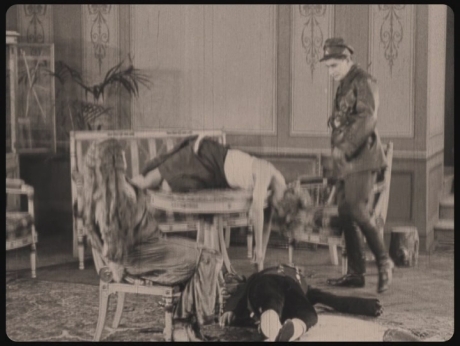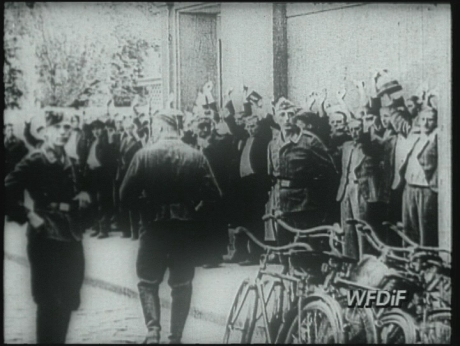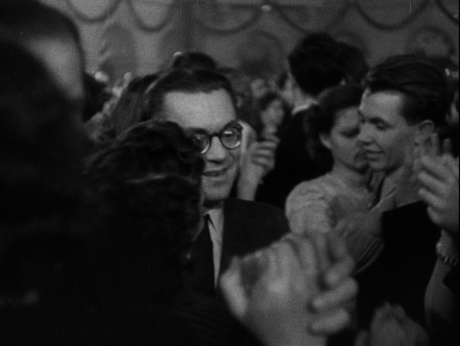
 overview
overview
About the film
Scenes from the filming of a film about Theresienstadt ghetto.
Person: Olaf Sigismund (cameraman and SS-Hauptsturmführer), Loris Sušický (inmate), Karel Schwenk (inmate), Gerhard Günnel (SS Obersturmführer)
Time: 1942
Place: Terezin, Theresienstadt
Sound format: none
Aspect ratio: 4:3
Colour: black and white
sequence description
| 00:00:00:00 | Inside of a cafe, a band is playing: from the left the violinist, behind him – the double bass player, in the middle of the group – the accordionist, to the right – the drummer and the clarinetist. Clients are sitting at the tables. |
| 00:00:03:02 | A man with a Star of David stitched to his jacket and a little girl are sitting at the table. |
| 00:00:07:24 | A waitress is handing out cups with tee or coffee. |
| 00:00:16:13 | Panorama of the inside of the cafe, the man and the little girl are coming to the table and taking a seat. |
| 00:00:27:13 | The band and two waitresses. A Star of David is to be seen on the apron of a waitress serving beverages. |
| 00:00:42:09 | Clapping audience. |
| 00:00:48:17 | The inscription on the front door of the cafe saying: “Die Eintrittskarte ist bei Eintritt und Verlassen des Kaffeehauses unbedingt vorzuweisen!” (“The entrance card is to be shown while entering and leaving the coffeehouse!”). Man leaving the cafe through the door (the same footage repeated twice). |
| 00:00:58:21 | Two German soldiers, the man on the left (cameraman Olaf Sigismund) is filming another soldier standing on a hill and then lifting up a camera on tripod. |
| 00:01:03:08 | Three German soldiers from the film crew setting up a camera on tripod, in the background: signboard. The cameraman is filming the soldier standing on the hill, two other men are standing next to the cameraman. |
| 00:01:18:20 | Signboards. The first signboard saying “Theresienstadt Terezin, Bezirk Raudnitz a.d.E., Okres Roudnice n.L.” The second signboard saying “Der Standortälteste Theresienstadt Geschäftszimmer im Stabsgebäude am Marktplatz.” |
| 00:01:26:07 | Cameraman is looking through a camera. Three members of the film crew are standing next to the camera on tripod. A cyclist is passing by. The cameraman is changing tape. |
| 00:01:52:10 | Film crew is getting into a car and then is leaving. |
| 00:02:06:12 | An armed Czech gendarme walks towards the camera (repeated scene). Signboard: “Jüdisches Siedlungsgebiet, Stehenbleiben verboten!”. On the right, there is a barbed wire fence. |
| 00:02:44:16 | Concentration camp theater group: a troupe of actors is standing on stage while a performance is going on. One of the actors is tearing a newspaper into pieces and putting the pieces in his mouth (Loris Sušický). The actors are playing instruments. Behind the actors, there is a scenery made out of hanging, painted sheets. |
| 00:03:23:10 | Actress on stage: she is dancing – at first among suitcases and then while carrying a bag. |
| 00:03:43:08 | Audience watching the performance. |
| 00:03:52:17 | Two actors are performing a scene at barber shop (The Barber - Karel Schwenk). Shaving with the use of a huge straight razor. |
| 00:04:27:17 | Collective scene, a bunk bed is a stage prop. |
| 00:04:39:17 | Portrait of a spectator: German serviceman is sitting, looking in the camera, saying something and laughing (Gerhard Günnel, SS Obersturmführer). |
| 00:04:47:19 | Puppet theater. Painted curtain is going up uncovering a stage with puppets. Acting the puppets. |
| 00:05:34:16 | Association football game. Film crew is passing next towards to the crematorium. |
| 00:06:11:07 | Men digging a trench with shovels. |
| 00:06:16:10 | Inmates building the railway line in Bohušovice-Bauschowitz. Two cameramen are filming the working men. Mine cars filled with dirt sit on the tracks. One of the cameramen. Close-up of a smiling woman. Dumping the dirt out of the mine cars. |
| 00:07:09:24 | German soldiers filming the inmates from the inside of an open rail car pushed by men along track. In the background: vans and open freight cars (repeated scene). |
| 00:08:02:18 | Close-up of a driver sitting in a car. |
| 00:08:07:21 | Car parked on the street (lining Theresienstadt's town park – Brunnen park). Dim interior of an unidentified room and dark silhouette. A group of people standing on the street. |
hide tab

 comment
comment
hide tab



















Working material. Film discovered in 1994. The material presents a film crew at filmset during shooting film about the ghetto in Theresienstadt.
The unethical use of film and photo cameras which captured and vilified Jewish life in Poland began in 1939 with an invasion of German cameramen and photographers who followed in the footsteps of the military. Five weeks after the attack, the first “ghetto” was established in former Piotrków Trybunalski, now called Petrikau on Reinhard Heydrich’s orders. More “ghettos” followed until the end of the year, including Masovian Płock (Plotzk, later called Schrötterburg) where 10.000 Jews were interned, and, in December, Radomsko, with 20.000 prisoners. (1)
On the newly drawn political European map the “racially inferior” were to be marginalised, isolated, exploited and eliminated. The spatial and social institution of the “ghetto“ was to play a double role. After the public ostracization of Jews with armbands and stars, the “ghetto” became an early tool of spatial segregation and withdrawal of the technologies of the Holocaust from the public eye. At the same time the “ghetto” became a productive resource of propaganda material for Nazi media. In this sense the artificially created “ghetto” was one of the early institutional apparatuses of the genocidal phase of the Holocaust, intimately connected with the optical apparatus recording the results of Nazi biopolitics. (…) Whereas for Goebbels the term “ghetto film” seemed to be a clear concept and synonymous with another composite typical for the NS jargon, the “Judenfilm”, today’s audiences and scholars will feel uneasy when confronted with the word without quotation marks. The same is true for the Nazi version of the word “ghetto” which deserves always to be marked as a quote, similar to the Nazi terms “Aryan” or “Final Solution”. (…) What are “ghetto films”? The surviving examples of this dubious genre – especially if the footage was not included in published newsreels, propaganda films or “Kulturfilms” – are almost as scarce as the documentation of the intentions behind their commissioning. Research during the last decade has at least been able to roughly establish the institutional background of the official cameramen and which groups or individuals would have commissioned or privately shot “ghetto films” (Uziel 2008, Horstmann 2009, Rother and Prokasky 2010, Zöller 2014).
(1) As most Polish cities were renamed by the German authorities, the newly established “ghettos” are called by their German names to mark the difference from the extinguished toponym which often was Slavic: Łódź became Litzmannstadt and Terezín became Theresienstadt.
Natascha Drubek, Editorial: The Ghetto as Holocaust Apparatus; http://www.apparatusjournal.net/index.php/apparatus/article/view/34/94
There was, in fact, a third filming project on the premises of the ghetto, unfortunately, only mentioned but not represented on the “Truth and Lies” DVD. Olaf Sigismund, the SS officer and film-maker employed by the Nazi security service, was present in Theresienstadt during the filming of the first film in November 1942. He in his turn filmed the process of the filming using a 16mm camera, probably, as documentation for his office in Berlin.
It might have been his footage that was displayed at the Czech exhibition “Truth and Lies” (first at the Jewish Museum, Prague, later in Terezín), but not included in the DVD material: a scene with a film crew and a crowd of extras, workers, and onlookers, under the supervision of the SS and the ghetto police, taking pictures of a train – most probably, a Transport -- arriving at the station. Adler’s expression “organisierter Wahnsinn” becomes an apt description without any metaphoricity whatsoever when one watches the installation from which the filming of the train was performed: a vagonette carrying the crew with a huge camera and all the necessary equipment, running to and fro along an additional line of rails laid parallel to the railway, pulled/pushed by hand by a group of prisoners, and repeating this apparently meaningless maneuver obsessively again and again, without an end. Adler could have witnessed similar scenes during the production of “organized madness” in the filming of the Gerron film.
Natascha Drubek, http://www.apparatusjournal.net (Apparatus issue 2)